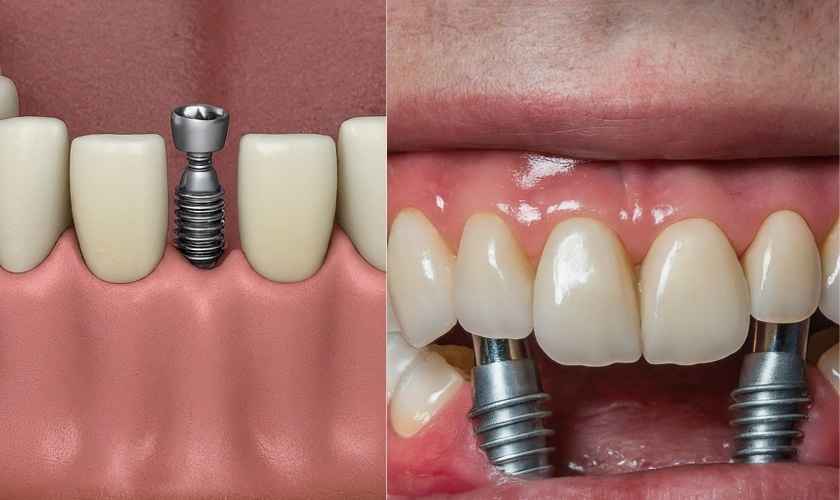Dental Sense - The Facts
Dental Sense - The Facts
Blog Article
The Basic Principles Of Dental Sense
Table of ContentsThe Of Dental SenseAbout Dental SenseThe Single Strategy To Use For Dental SenseThe Basic Principles Of Dental Sense
are medical devices operatively dental implanted into the jaw to restore an individual's ability to eat or their look. They provide assistance for man-made (phony) teeth, such as crowns, bridges, or dentures. When a tooth is shed because of injury or illness, a person can experience problems such as rapid bone loss, malfunctioning speech, or adjustments to chewing patterns that lead to pain.Oral implant systems include an oral implant body and oral implant abutment and may also consist of a joint addiction screw. Front tooth filling. The dental implant body is operatively inserted in the jawbone in place of the tooth's root. The dental implant abutment is generally affixed to the dental implant body by the joint fixation screw and expands through periodontals into the mouth to sustain the affixed artificial teeth
(https://www.tripadvisor.in/Profile/dentalsense1)Framework of The Oral Implant System picking dental implants, talk with your dental company regarding the prospective benefits and risks, and whether you are a prospect for the treatment. Things to take into consideration: Your total health and wellness is an essential consider determining whether you are an excellent prospect for oral implants, for how long it will require to recover, and just how long the implant might remain in place.
Smoking cigarettes might impact the healing procedure and reduce the lasting success of the dental implant. The healing process for the dental implant body may take numerous months or longer, during which time you typically have a momentary joint instead of the tooth. the dental implant procedure: Thoroughly adhere to the dental health directions offered to you by your dental provider.
The Buzz on Dental Sense
Implant failing can result in the requirement for one more procedure to repair or change the implant system. Brings back the capacity to chew Brings back aesthetic look Aids maintain the jawbone from diminishing because of bone loss Maintains the wellness of the surrounding bone and periodontals Aids maintain surrounding (neighboring) teeth stable Improves lifestyle Damages to bordering all-natural teeth during implant placement Injury to the surrounding tissues during surgical treatment, such as sinus opening Injury throughout surgical treatment (for instance, crack of bordering jawbone) Insufficient feature, such as seeming like the teeth do not attack with each other normally A sensation that the tooth is loose or twisting in area arising from an abutment screw loosening up Implant body failing (looseness of the dental implant body) due to systemic infection, which might be most likely in people with uncontrolled diabetes as a result of neighborhood infection in bone and periodontals sustaining the dental implant body as a result of delayed recovery, which might be a lot more likely in individuals that smoke Difficulty cleaning up the periodontals around the implant, resulting in poor oral health Neglected gum condition Post-surgical numbness because of nerve impingement or damages Always notify health and wellness treatment carriers and imaging technicians that you have oral implants prior to any type of magnetic resonance imaging (MRI) or x-ray treatments.
FDA is not aware of any kind of negative events reported for MRI or x-ray treatments with dental implants. Oral implants systems are generally constructed from products that comply with international consensus criteria of the International Company for Standardization (ISO) or ASTM International. These criteria have details of what makes a safe material.

A dental implant is a framework that replaces a missing tooth. With screw-like devices, the doctor inserts a dental implant right into the jawbone, and it acts as an anchor for an artificial tooth, called a crown. A device called an abutment links the fabricated tooth to the dental implant. The crown is personalized to fit the individual's mouth and match the color of their teeth.
Dental Sense - The Facts
Some individuals are not qualified for oral implant surgical procedure. It is for dental specialists to run on individuals with: intense illnessuncontrollable metabolic diseasebone or soft tissue illness or infectionIf these concerns are solved, a person can have the surgery. In, oral doctors refrain from operating individuals with: If people with any of the above undergo dental implant surgery, there is a higher threat of the dental implant falling short.

Dental implant surgery is a customized procedure. Give you time to recover. Connect the blog post and final crown, bridge or denture.
Next, your specialist will very carefully place the dental implant into your jaw. If your implant is near the front of your mouth, your dentist will certainly make a momentary tooth for you to use until you recover.
All About Dental Sense
Throughout the recovery phase, your jawbone must fuse to the oral implant. This process can take anywhere from 3 to 9 months.
When your dental implant heals, your dental expert can connect the joint (little connector post) and your final remediation (crown, bridge or denture). This generally takes about one hour to complete and might require a second small surgical treatment. You shouldn't really feel any kind of discomfort during your dental implant procedure since your copyright will certainly use drug to numb your gums.
Report this page